 Christianity
means a belief in the divinity of Jesus Christ.
follower
of the doctrines associated with Him is called a Christian. Christianity
means a belief in the divinity of Jesus Christ.
follower
of the doctrines associated with Him is called a Christian.
|
This discussion
will focus on Roman Catholics (in the West usually simply called "Catholics")
since it is the most numerous group and they are the ones English lit majors
are most likely in need of understanding.
Catholicism
The most "famous"
and powerful section of Catholicism is
Roman Catholic, called this since the seat of the Church is in Rome,
but technically in its own country, a small city-state called Vatican City.
The leader of this branch of Catholicism is called The Pope, currently
Pope John Paul II. Until 1963, all Roman Catholic services and communications
were done in Latin. Usually in the West, references to The Church
(capitalized) mean The Roman Catholic Church. For almost 1500 years it
was the only major Western Christian group, so it was The Church.
It is also referred to in some literature as Holy Mother Church,
a reflection of the love and the relationship Catholics envision to have
with their church.
An early split in
Catholicism created the Orthodox churches in countries which were
once part of the Byzantine Empire, the most famous of which are the
Greek and Russian Orthodox Churches. They are headed by Metropolitans,
and services are held in the national language of the Church, so a Greek
Orthodox service in the United States would still be in Greek.
A hybrid of these two are the Eastern
Rite Churches. These are technically Roman Catholic, since they follow
the dictates of the pope, but they use a form of worship closer to the
Orthodox Church, and are associated with an Eastern European country, i.e.,
Ukrainian Church.
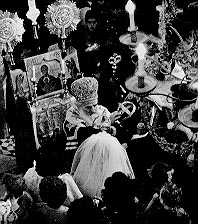 A marriage in an Eastern Orthodox Church.
The priest holds the wedding crowns over the heads of the bride and groom.
(Parrinder 437)
A marriage in an Eastern Orthodox Church.
The priest holds the wedding crowns over the heads of the bride and groom.
(Parrinder 437) |
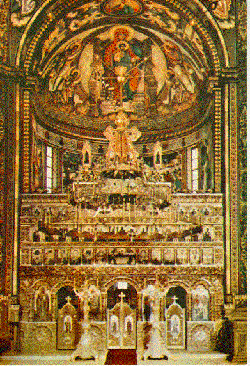 The Inside of a Romanian Church
from Online
Icons Larger picture
The Inside of a Romanian Church
from Online
Icons Larger picture
|
Major beliefs
These are the beliefs that make Roman
Catholicism what it is:
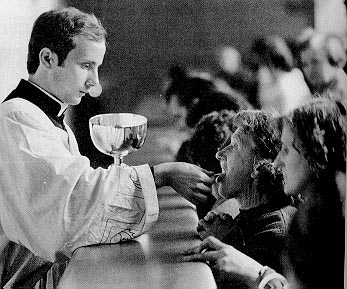
|
-
The most "controversial" and the real "acid
test" between Catholics and Protestants is the teaching of transubstantiation,
a Catholic belief that during the communion (eucharist) ceremony, the bread
and wine actually becomes the body and blood of Jesus Christ.
-
The infallibility of the pope on matters
of doctrine (called "speaking ex cathedra"¨)
The doctrine of transubstationation has aroused
great controversy over the centuries. (Parrinder
428) |
|
|
The Immaculate Conception
of Mary (means that she was born without "original sin"--the sin humans
carry from Adam and Eve's first disobedience). This is often confused
with the Virgin Birth of Jesus. This is the belief that the Holy
Spirit made Mary pregnant,
"The Virgin of the Grotto"
at Lourdes, France. The Virgin
Mary is said to have appeared to St. Bernadette 18 times in 1858 and to
have revealed to her a spring whose waters have the power of curing ills.
(Langley 165) |
-
Sacraments are special events in
Catholics lives when God sends special grace. Catholics recognize seven:
baptism, communion, confession, confirmation, marriage, holy orders,
and anointing of the sick (this used to be called "Extreme
Unction" and was used when a person was dying, but it was opened up
to the ill in the late 20th century).
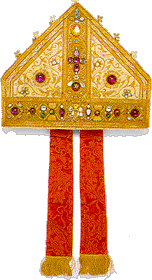
-
The Catholic Church system is hierarchical.
For Roman Catholics ranking goes pope, cardinals, bishops, priests.
There are also subdivisions with bishops and priests, but we needn't go
into that here.
Left: Bishop's mitre (Langley)
-
Sainthood is something special in Catholicism
(and for some Protestant groups as well). But for Catholics, there is a
special, official process the Church uses to call someone a saint. This
can be confusing to non-Catholics, but if someone gets named an official
Saint, they were most likely better than I'm ever going to be.
-
There are also Patron saints
of just about everything and everywhere. These are not gods and goddesses
as my polytheistic students often think, but a saint who takes special
interest in the needs of the group he or she represents and then is willing
to intercede with God for special intentions. Important ones for English
majors:

|
The Blessed Mother - Patron of China
St. George - Patron of England
St. Patrick, St. Brigid, St. Columba
- Patrons of Ireland
St. Andrew - Patron of Scotland
St. David - Patron of Wales
The Immaculate Conception - Patron
of USA
St. Cecelia - Patron of music
Left: St. Patrick
Patrick is invoked against snakes and
is often portrayed driving them before him. (Langley
94)
Right: St. Cecelia The
Angel in this romanticized portrayal of Cecilia is holding the roses that
are one of her emblems. (Langley 125) |
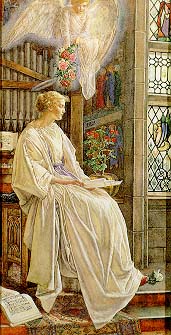
|
Major Holidays/Seasons
Advent
is the four week period before Christmas, a time for preparation
for the birth of Jesus. During this times traditional Catholics often light
the Advent Wreath: three purple
candles and one pink. For the first three Sundays of Advent a purple
candle is lit, and on the fourth Sunday the pink is lit. These are often
decorated beautifully and build the anticipation for Christmas.
Lent
is the 40 days before Easter. It is a time of repentance, sacrifice
and preparation for the coming holiday. It starts on a day called
Ash Wednesday, a day many Christian groups, not just Catholics,
have their forehead marked by ashes in the sign of the Cross. (T.S. Eliot
mentions this day in a famous poem of the same name.)
Also See Christmas
and Easter.
Relevant Links
-
The Catholic Encyclopedia
on-line: run by the Knights of Columbus, a major Catholic service
organization.
-
The Holy See: Vatican Web
Site
Recent photographs of the Pope's appearances and the text from his
speeches are made available on this site, which is updated frequently.
-
Vatican
Exhibit: Rome Reborn
Online exhibit traces the development of Vatican City during the Renaissance,
including Vatican Library, Archaeology, Humanism, Mathematics, Music, Medicine
and Biology, Nature Described, Orient to Rome, Rome to China.
-
Christus Rex: Images of
Vatican City, the Sistine Chapel, the Rafael Stanze and Loggia, and Vatican
Museums. Multilingual translations of the speeches and writings of Pope
John Paul II..
-
Holy
See (Vatican City) Geography: information about the country of
Vatican City itself
Picture source:
1. Parrinder,
Geoffrey, ed. World Religions: From Ancient History to the Present.
New York: Facts on File, 1971.
2. Langley, Myrtle.
Religion (Eyewitness Guides.) New York: Dorling Kindersley,
1996.
